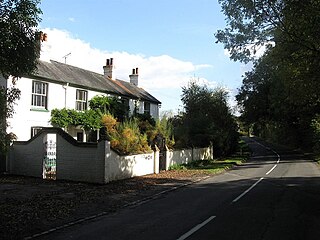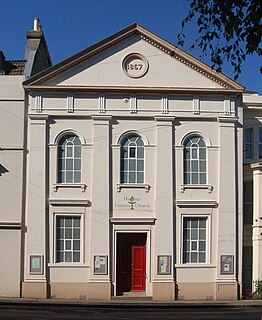
Wivelsfield village and the larger adjacent village of Wivelsfield Green are the core of the civil parish of Wivelsfield in the Lewes District of East Sussex, England. The villages are 9.3 miles (15.0 km) north of the city of Brighton and Hove.

Zion Chapel is a former Strict Baptist place of worship in the village of Newick in Lewes District, one of six local government districts in the English county of East Sussex. The tiny building was opened for worship in 1834 in a part of Sussex which was a hotbed of Protestant Nonconformism, and remained as one of three places of worship in the small Wealden village until 2001, when it was sold for conversion to houses. The chapel is protected as a Grade II listed building.

Ebenezer Particular Baptist Chapel is a former Strict Baptist place of worship in Hastings, East Sussex, England. Founded in 1817 by members of the congregation of an older Baptist chapel in the ancient town, it was extended several times in the 19th century as attendances grew during Hastings' period of rapid growth as a seaside resort. It was closed and converted into a house in the late 20th century, but still stands in a prominent position in Hastings Old Town. English Heritage has listed the building at Grade II for its architectural and historical importance.

Rehoboth Chapel is a former Strict Baptist place of worship in the hamlet of Pell Green in East Sussex, England. Pell Green is in the parish of Wadhurst in Wealden, one of six local government districts in the English county of East Sussex, and stands on the road between the market town of Wadhurst and the village of Lamberhurst in the county of Kent. Built in 1824 to replace an earlier meeting place for local Baptists, it continued in religious use until the late 20th century. The weatherboarded building—now a house—is of a similar design to another Baptist chapel at nearby Shover's Green. The building is Grade II listed.

Shover's Green Baptist Chapel is a former Strict Baptist place of worship in the hamlet of Shover's Green in East Sussex, England. Shover's Green is in Wealden, one of six local government districts in the English county of East Sussex, and stands on the road between the market town of Wadhurst and the village of Ticehurst in the neighbouring district of Rother. Founded by Strict Baptists from nearby Burwash in 1816, the chapel—one of three Baptist places of worship in Wadhurst parish—continued to serve the community until the 1970s, when it was sold for conversion to a house. Its design is similar to that of the nearby Rehoboth Chapel at Pell Green. The chapel is protected as a Grade II Listed building.

Providence Chapel is a former independent Calvinistic place of worship in the village of Hadlow Down in Wealden, one of six local government districts in the English county of East Sussex. Although built in 1849, the chapel can trace its origins to the founding in 1824 of an Independent place of worship in the village. The new building was in religious use for nearly 150 years, but storm damage led to its closure and conversion into a private dwelling in 1993—although its former graveyard survives. The chapel is a Grade II Listed building.

Rye Particular Baptist Chapel is a former Strict Baptist place of worship in Rye, an ancient hilltop town in Rother, one of six local government districts in the English county of East Sussex. Built in the 18th century on the site of a decaying Quaker meeting house, it served Baptists in the town for many years until a new chapel was constructed nearby. The chapel is a Grade II Listed building.

Southover General Baptist Chapel is a former Baptist place of worship in the ancient village of Southover, now part of the town and district of Lewes, one of six local government districts in the English county of East Sussex. Founded in 1741 as the first Baptist place of worship in the area, it attracted a congregation of General Baptists whose theological views gradually moved towards Unitarianism. This led to their union with the members of the nearby Westgate Chapel, after which the flint and brick building housed other congregations and secular groups before its conversion to a house. The building is protected as a Grade II by English Heritage.

Billingshurst Unitarian Chapel is a place of worship in Billingshurst in the English county of West Sussex. The cottage-like building was erected in 1754 for General Baptists, hence its original name of the Billingshurst General Baptist Chapel, but the congregation moved towards Unitarian beliefs in the 19th century, and still maintain these. It is a member of General Assembly of Unitarian and Free Christian Churches, the umbrella body for British Unitarians.

Trinity Congregational Church, later known as Union Chapel, is a former place of worship for Congregationalists and Independent Christians in Arundel, an ancient town in the Arun district of West Sussex, England. Protestant Nonconformism has always been strong in the town, and the chapel's founding congregation emerged in the 1780s. After worshipping elsewhere in the town, they founded the present building in the 1830s and remained for many years. Former pastors included the poet George MacDonald. Robert Abraham's distinctive neo-Norman/Romanesque Revival building was converted into a market in the 1980s and has been renamed Nineveh House. The church is a Grade II Listed building.

Horsham Unitarian Church is a Unitarian chapel in Horsham in the English county of West Sussex. It was founded in 1719 to serve the large Baptist population of the ancient market town of Horsham—home of radical preacher Matthew Caffyn—and the surrounding area. The chapel's congregation moved towards Unitarian beliefs in the 19th century, but the simple brick building continued to serve worshippers drawn from a wide area of Sussex. It is one of several places of worship which continue to represent Horsham's centuries-old tradition of Protestant Nonconformism, and is the town's second oldest surviving religious building—only St Mary's, the parish church, predates it. English Heritage has listed the chapel at Grade II for its architectural and historical importance.

Robertsbridge United Reformed Church is a former United Reformed Church place of worship in Robertsbridge, a village in the district of Rother in the English county of East Sussex. Built for Congregational worshippers in 1881 following their secession from a long-established Wesleyan Methodist chapel, it was the third Nonconformist place of worship in the village, whose nearest parish church was in the neighbouring settlement of Salehurst. Like the former Strict Baptist and Methodist chapels in the village, which have both closed, it no longer serves Robertsbridge as a place of worship. Local architect Thomas Elworthy's distinctive design—a "rich" and highly decorated blend of several styles—has divided opinion amongst architectural historians. English Heritage has listed the church at Grade II for its architectural and historical importance.

Bethel Strict Baptist Chapel is a former place of worship for Strict Baptists in Robertsbridge, a village in the district of Rother in the English county of East Sussex. Partly hidden behind ancient buildings on the village High Street, the simple brick chapel was erected in 1842 on the initiative of James Weller, a "somewhat remarkable man" whose preaching had attracted large audiences across Kent and East Sussex in the previous decade. The Strict Baptist cause was historically strong in East Sussex, and Protestant Nonconformism thrived in Robertsbridge, which was distant from the nearest Anglican parish church. The chapel closed in about 1999 and permission was granted for its conversion into a house. English Heritage has designated it a Grade II Listed building.

Bethel Baptist Chapel is a Strict Baptist place of worship in the village of Wivelsfield in East Sussex, England. The cause was founded in 1763 by members of a chapel at nearby Ditchling; Henry Booker and other worshippers seceded and began to meet at Wivelsfield after hearing a sermon by George Whitefield. Although some members of the new church soon returned to the Ditchling congregation, the cause thrived under Booker's leadership, and the present chapel—a building of "quiet and unassuming elegance" set in its own graveyard—was erected in 1780. It has served the Strict Baptist community continuously since then, and members founded other chapels elsewhere in Sussex during the 18th and 19th centuries. The chapel is a Grade II Listed building.

Zoar Strict Baptist Chapel is a Strict Baptist place of worship in the hamlet of Lower Dicker in the English county of East Sussex. Founded in 1837 and originally known as The Dicker Chapel, the "large and impressive" Classical/Georgian-style building stands back from a main road in a rural part of East Sussex. The 800-capacity building included a schoolroom and stables when built, and various links exist between people and pastors associated with the chapel and other Strict Baptist and Calvinistic causes in the county, which is "particularly well endowed with [such] chapels".

Meadrow Unitarian Chapel is a Unitarian chapel in the Farncombe area of Godalming, Surrey, England. It is part of the London District and South Eastern Provincial Assembly of Unitarian and Free Christian Churches, one of 16 districts within the General Assembly of Unitarian and Free Christian Churches, the umbrella organisation for British Unitarians.

Five Ash Down Independent Chapel is an independent Evangelical church in the Reformed (Calvinist) tradition in the hamlet of Five Ash Down, East Sussex, England. Founded in 1773 in the house of a local man, Thomas Dicker senior, the cause developed so rapidly that a church was founded and a permanent building erected for the congregation 11 years later. The church was run along Calvinistic lines at first, in common with many new chapels in late 18th-century Sussex, and an early group of seceders from the congregation founded a chapel in nearby Uckfield which was run in accordance with Baptist theology. The Five Ash Down chapel has been described as "the parent of many other places [of worship] both Baptist and Independent" across Sussex, and it has continued into the 21st century—now as a small Evangelical fellowship but still worshipping in the original chapel, whose present appearance is a result of expansion and refronting during the Victorian era.

Uckfield Baptist Church is a Baptist congregation based in the town of Uckfield in East Sussex, England. Although services now take place in a school, the cause—founded in 1785 by seceders from the nearby Five Ash Down Independent Chapel—had its own chapel from 1789 until 2005, when the building closed and was sold for residential conversion. The "simple brick chapel" was rebuilt in 1874 and has been listed at Grade II for its architectural and historical importance.

Hastings Unitarian Church, also known as Hastings Unitarian and Free Christian Church, is a place of worship for Unitarians in the town and borough of Hastings, one of six local government districts in the English county of East Sussex. It has been in continuous use since it was built in 1868, having been founded the previous year by prominent Unitarian John Bowring for a congregation which had met in hired premises since 1858. The church, designed by George Beck, is Neoclassical in style and has an 18th-century organ.


























